╔
La transformación del Puerto de Málaga: nuevos retos para la integración puerto-ciudad
Introducción
Introduction
El puerto de Málaga, con una historia que se remonta a la época fenicia, ha sido un motor económico clave en el desarrollo urbano de la ciudad, facilitando el comercio y las relaciones con otros territorios a través del Mediterráneo (Machuca Santa-Cruz, 1997). En el último siglo, el puerto ha experimentado una evolución significativa que lo ha llevado de ser un centro de actividad comercial e industrial a convertirse en un espacio de ocio y recreo integrado en la vida urbana, gracias a un importante proceso de regeneración urbana.
El crecimiento industrial del siglo XIX aceleró la actividad de esta infraestructura situada a los pies del Monte de Gibralfaro, que requeriría, por temas de seguridad, de su delimitación física. Estas barreras no sólo consiguieron la separación física del puerto y la ciudad, sino también una barrera psicológica que ha perdurado en el imaginario de la ciudadanía hasta hace poco más de dos décadas (Andrade & Peralta, 2015). Ahora bien, la desindustrialización experimentada en el último tercio del siglo XX, junto al proceso de expansión y crecimiento del puerto hacia el mar, abrió la posibilidad de recuperar los terrenos portuarios más próximos a la ciudad histórica para uso ciudadano.
El Plan Especial del Puerto de Málaga, aprobado en 1998, marcó un punto de inflexión en la relación puerto-ciudad, al reimaginar la infraestructura como un espacio multifuncional que combinase la ampliación de las instalaciones para aumentar la actividad portuaria, el tráfico de mercancías, pasajeros y cruceros, con la recuperación de parte de las instalaciones para actividades comerciales y socioculturales, buscando integrar el puerto en la ciudad (Costa et al., 2005). El objetivo era no solo mejorar la calidad de vida de los malagueños, sino impulsar también un modelo de ciudad turística que empezaba a vislumbrarse desde las autoridades públicas municipales (López-Bravo & Navas-Carrillo, 2019).
The port of Malaga, with a history dating back to the Phoenician era, has been a key economic driver in the urban development of the city, facilitating trade and relations with other territories across the Mediterranean (Machuca Santa-Cruz, 1997). In the last century, the port has undergone significant evolution, transforming from a hub of commercial and industrial activity into a leisure and recreation space integrated into urban life, thanks to a major urban regeneration process.
The industrial growth of the 19th century accelerated the activity of this infrastructure, located at the foot of Mount Gibralfaro, which required, for security reasons, its physical delimitation. These barriers not only achieved the physical separation of the port and the city, but also created a psychological barrier that persisted in the public’s imagination until just over two decades ago (Andrade & Peralta, 2015). However, the deindustrialization experienced in the last third of the 20th century, along with the process of port expansion and growth towards the sea, opened the possibility of recovering the port areas closest to the historic city for public use.
The Special Plan for the Port of Malaga, approved in 1998, marked a turning point in the port-city relationship by reimagining the infrastructure as a multifunctional space that combined the expansion of facilities to increase port activity, the traffic of goods, passengers, and cruises, with the recovery of part of the facilities for commercial and sociocultural activities, seeking to integrate the port into the city (Costa et al., 2005). The goal was not only to improve the quality of life for the people of Malaga but also to promote a model of a tourist city that was beginning to take shape among public authorities (López-Bravo & Navas-Carrillo, 2019).
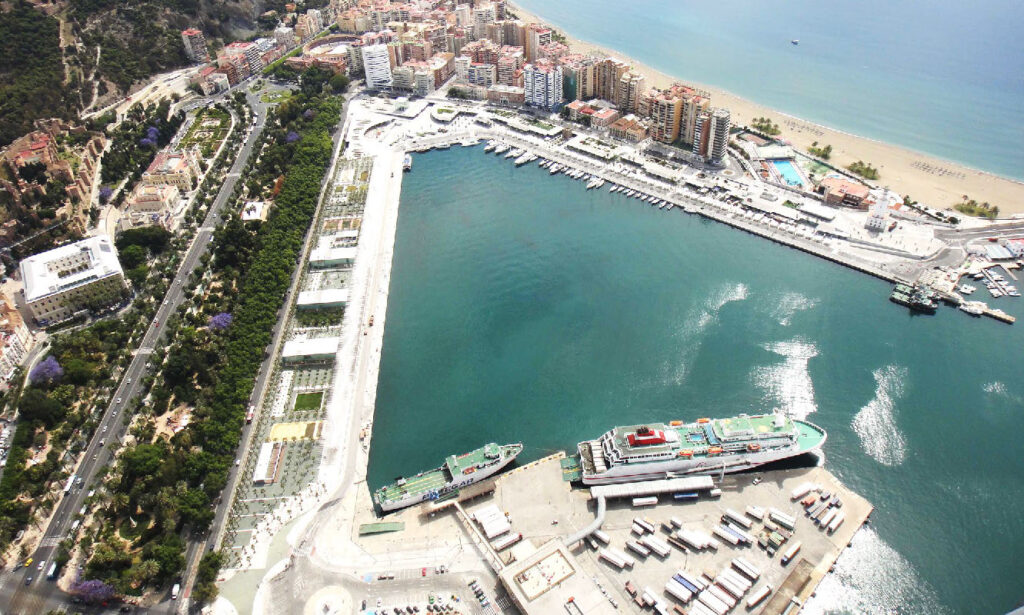
Vista de los muelles uno y dos tras la intervención. (Fuente: Autoridad Portuaria de Málaga).
View of docks one and two after the intervention. (Source: Port Authority of Malaga).
Proyectos como el centro comercial abierto en el Muelle Uno y el Palmeral de las Sorpresas en el muelle 2 no solo han modificado el paisaje urbano de la ciudad en las inmediaciones de su centro histórico, sino que han transformado áreas previamente reservadas para actividades portuarias en espacios accesibles para el ocio tanto de residentes como de visitantes. Hitos como el Centre Pompidou Málaga, sede del Centro Nacional de Arte y Cultura Georges Pompidou de Francia, la construcción de la terminal de cruceros o, más recientemente, la marina y dársena de megayates han contribuido a la evolución de Málaga como destino turístico destacado en el Mediterráneo.
La gran transformación del puerto en las últimas décadas ha sentado las bases para ambiciosos proyectos para el desarrollo futuro de la ciudad. Actuaciones que se integran en el Plan Especial del Puerto como la del controvertido hotel en el dique de Levante, la ordenación del entorno del muelle Heredia (muelle 4) o la de la plataforma de San Andrés, junto a nuevos retos y oportunidades de transformación urbana, como el denominado Plan Litoral, que vendrán a redefinir nuevamente las relaciones puerto-ciudad.
Projects such as the open-air shopping center at Muelle Uno and the Palmeral de las Sorpresas at Muelle 2 have not only altered the urban landscape of the city near its historic center but have also transformed areas previously reserved for port activities into spaces accessible for leisure, both for residents and visitors. Landmarks such as the Centre Pompidou Malaga, the headquarters of the Centre National d’Art et de Culture Georges Pompidou in France, the construction of the cruise terminal, and more recently, the marina and megayacht dock, have contributed to Malaga’s evolution as a prominent tourist destination in the Mediterranean.
The significant transformation of the port in recent decades has laid the groundwork for ambitious projects for the future development of the city. Actions that are part of the Special Port Plan, such as the controversial hotel on the Levante dock, the planning of the Heredia dock area (Muelle 4), or the San Andrés platform, along with new challenges and opportunities for urban transformation, such as the so-called Litoral Plan, will redefine the port-city relationship once again.
La torre del dique de levante: un proyecto controvertido
The Levante Dock Tower: A Controversial Project
Uno de los proyectos futuros más destacados y controvertidos es la construcción de una torre en el dique de Levante. Este rascacielos, destinado a ser un hotel de lujo, busca posicionar a Málaga como un destino de referencia para el turismo de alto nivel. Con un diseño arquitectónico actual, la torre promete ser un nuevo icono para la ciudad y un motor económico y de empleo significativo. Se busca que la torre contribuya a que la estrategia de Málaga evolucione para diversificar su oferta turística, atrayendo a un segmento de mercado diferente al tradicional.
No obstante, el proyecto ha generado un debate considerable. Su altura y ubicación vendrían a alterar el paisaje urbano y desvirtuar la relación histórica entre la ciudad y el puerto (Bernal Santa Olalla, 2028). También podría interferir en la percepción de la Farola, recientemente declarada Bien de Interés Cultural. Su enfoque hacía el turismo de lujo podría aumentar alterar las dinámicas residenciales de los barrios más próximos, limitando el acceso de la ciudadanía local al litoral, dada la clara relación entre renovación urbana y procesos de gentrificación urbana (Fernández-Salinas & Silva Pérez, 2016). Además del fuerte impacto medioambiental que conlleva la construcción de un edificio en altura en un entorno marítimo tan vulnerable.
One of the most prominent and controversial future projects is the construction of a tower on the Levante dock. This skyscraper, intended to be a luxury hotel, aims to position Malaga as a leading destination for high-end tourism. With a contemporary architectural design, the tower promises to become a new icon for the city and a significant economic and employment driver. The goal is for the tower to help Malaga’s strategy evolve by diversifying its tourism offer and attracting a different market segment from the traditional one.
However, the project has sparked considerable debate. Its height and location would alter the urban landscape and distort the historical relationship between the city and the port (Bernal Santa Olalla, 2028). It could also interfere with the perception of the Farola, recently declared a Cultural Heritage Site. Its focus on luxury tourism could disrupt the residential dynamics of the nearby neighborhoods, limiting local citizens’ access to the coastline, given the clear link between urban renewal and gentrification processes (Fernández-Salinas & Silva Pérez, 2016). Additionally, there is the significant environmental impact associated with constructing a tall building in such a vulnerable maritime environment.
Ordenación del entorno del dique de levante. Modificación del Plan Especial del Puerto. (Fuente: Autoridad Portuaria de Málaga, 2023).
Planning of the surroundings of the eastern breakwater. Modification of the Special Plan of the Port. (Source: Port Authority of Malaga, 2023).
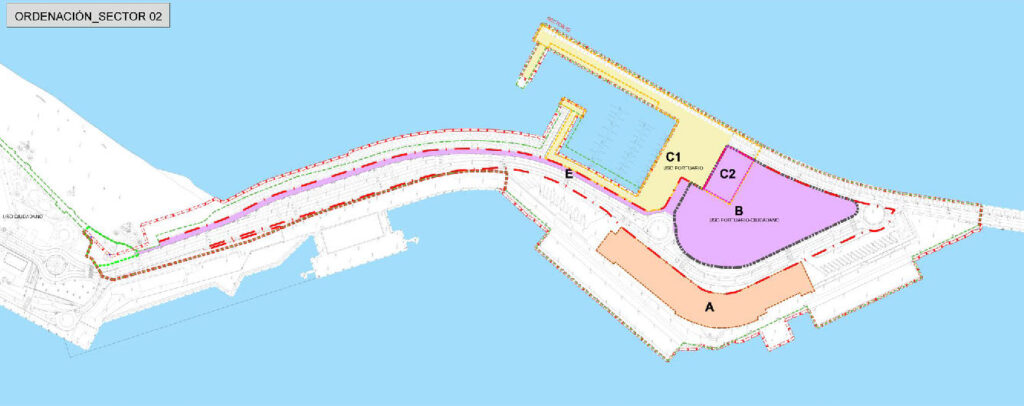
Infografía de la propuesta de hotel en el dique de levante. (Fuente: Autoridad Portuaria de Málaga, 2023).
Infographic of the proposed hotel on the eastern breakwater. (Source: Port Authority of Malaga, 2023).
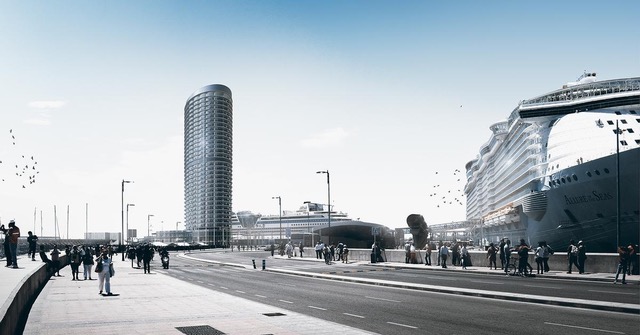
Plataforma de San Andrés: un espacio para la cultura
San Andrés Platform: A Space for Culture
La plataforma de San Andrés, situada en el extremo occidental del puerto, es otro de los entornos cuya transformación es clave para el futuro de Málaga. Esta área, que ha sido tradicionalmente industrial, se encuentra en un proceso de transformación para convertirse en un espacio multifuncional orientado tanto a actividades portuarias como urbanas en conexión tanto con el paseo marítimo de Antonio Machado como con el Parque de Huelin, en el terreno liberado tras el desmantelamiento de los depósitos de Campsa (Márquez-Ballesteros et al., 2024).
Entre las propuestas para la plataforma de San Andrés destaca la creación de un puerto deportivo, que incluirá amarres para embarcaciones de recreo y servicios asociados. Esta nueva infraestructura recreativa estará acompañada por la construcción de zonas comerciales y de ocio que dinamizarán la economía de los barrios circundantes y a la que se suman piezas ya construidas como la Instituto Oceanográfico y otras instalaciones de la autoridad portuaria.
Una de las piezas centrales de este proyecto será la construcción del Auditorio de la Música de Málaga, una infraestructura cultural de gran envergadura que busca consolidar a la ciudad como epicentro de eventos artísticos y musicales de toda la Costa del Sol. Este auditorio, sede de la Orquesta Filarmónica de Málaga y diseñado para albergar eventos de hasta 1.622 personas y espectáculos de ópera de hasta 1.743, busca convertirse en un hito arquitectónico y cultural a nivel nacional e internacional (Benedicto Calahorra, 2017).
Además, se está desarrollando el proyecto para la peatonalización y renaturalización del sector limítrofe Huelin-Ayala. Esta actuación no solo proporcionará un espacio verde adicional en uno de los sectores más densamente poblados de la ciudad, sino que también actuará como un corredor ecológico que mejorará la sostenibilidad y el confort climático del entorno (Gerencia Municipal de Urbanismo de Málaga, 2024).
The San Andrés platform, located at the western end of the port, is another key area undergoing transformation for the future of Malaga. This traditionally industrial zone is in the process of being converted into a multifunctional space catering to both port and urban activities, connecting the Antonio Machado seafront promenade with Huelin Park, on land freed up after the dismantling of the Campsa storage tanks (Márquez-Ballesteros et al., 2024).
Among the proposals for the San Andrés platform, the creation of a marina stands out, which will include moorings for recreational boats and associated services. This new recreational infrastructure will be complemented by the construction of commercial and leisure areas, which will stimulate the economy of the surrounding neighborhoods, along with already built elements such as the Oceanographic Institute and other facilities of the port authority.
A central feature of this project will be the construction of the Malaga Music Auditorium, a large cultural infrastructure aimed at establishing the city as a hub for artistic and musical events across the Costa del Sol. This auditorium, home to the Malaga Philharmonic Orchestra and designed to host events with up to 1,622 people and opera performances for up to 1,743, aims to become an architectural and cultural landmark at both the national and international levels (Benedicto Calahorra, 2017).
Additionally, a project is underway for the pedestrianization and renaturalization of the Huelin-Ayala boundary sector. This initiative will not only provide additional green space in one of the city’s most densely populated areas but will also serve as an ecological corridor that enhances sustainability and the climatic comfort of the surrounding environment (Gerencia Municipal de Urbanismo de Malaga, 2024).
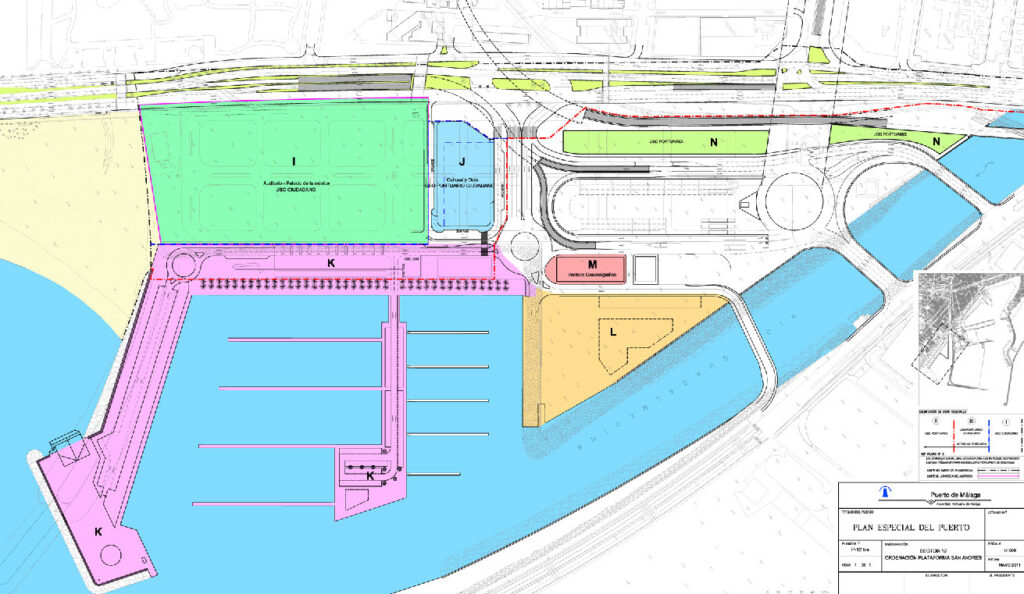
Ordenación Plataforma de San Andrés. Modificación de paramentos y de la dotación mínima de aparcamientos en la Plataforma del Auditorio. Plan Especial del Sistema General del Puerto de Málaga. (Fuente: Autoridad Portuaria de Málaga, 2011).
San Andrés platform planning. Modification of the walls and minimum provision of parking spaces on the Auditorium Platform. Special Plan for the General System of the Port of Malaga. (Source: Port Authority of Malaga, 2011).
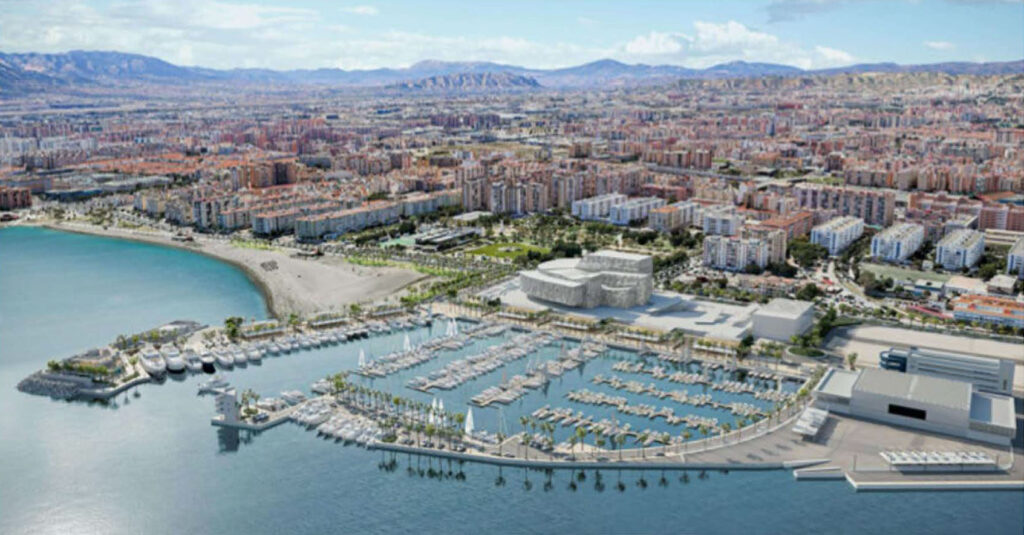
Infografía de las actuaciones previstas en la plataforma de San Andrés. Estudio de Detalle de ordenación de volúmenes de la Parcela K “Puerto Deportivo”. Plan Especial del Sistema General del Puerto de Málaga. (Fuente: Autoridad Portuaria de Málaga, 2024).
Infographic of the planned actions on the San Andrés platform. Detailed study of the volume arrangement of Plot K “Puerto Deportivo”. Special Plan for the General System of the Port of Malaga. (Source: Port Authority of Malaga, 2024).
Ordenación de Muelle Heredia: una nueva fachada al mar
Heredia Dock Development: A New Seafront Facade
El muelle 4 que discurre en paralelo a la Avenida Manuel Agustín Heredia representa una oportunidad única para reforzar la integración entre el puerto y la ciudad, al tiempo que modernizar la imagen autárquica que caracteriza a este entorno (Reinoso Bellido, 2005). Actualmente, este espacio combina funciones portuarias activas con áreas subutilizadas, lo que plantea el reto de equilibrar la operatividad portuaria con la creación de espacios accesibles para los ciudadanos.
El proyecto de ordenación del muelle 4 busca convertir esta área en un gran espacio de negocios, que complemente la actividad comercial y terciaria del centro de la ciudad y el Ensanche Heredia, actualmente conocido como Soho Málaga. Pero para ello es necesario desarrollar una serie de proyectos previos tales como el traslado del edificio de la Guardia Civil a la plataforma de San Andrés o de las instalaciones de la Agencia Tributaria a un nuevo edificio a la altura de la Alameda de Colón.
Este proyecto también busca conectar mediante vías peatonales y ciclistas el muelle portuario con el Ensanche Heredia y el centro histórico. La mejora de estas conexiones facilitará el acceso al puerto desde diferentes puntos de la ciudad, fomentando un uso más activo del espacio. Este proyecto supondrá la generación de una nueva fachada urbana y la renovación de un eje urbano de primer nivel que ha de desarrollarse en paralelo a la ejecución del Plan Litoral.
Muelle 4, running parallel to Avenida Manuel Agustín Heredia, represents a unique opportunity to strengthen the integration between the port and the city, while modernizing the self-sufficient image that characterizes this area (Reinoso Bellido, 2005). Currently, this space combines active port functions with underutilized areas, presenting the challenge of balancing port operations with the creation of accessible spaces for citizens.
The Muelle 4 development project aims to transform this area into a major business hub, complementing the commercial and service activities of the city center and the Ensanche Heredia, currently known as Soho Malaga. However, this requires the completion of several prior projects, such as relocating the Guardia Civil building to the San Andrés platform or moving the Tax Agency’s facilities to a new building near the Alameda de Colón.
This project also seeks to connect the port dock with Ensanche Heredia and the historic center via pedestrian and cycling routes. Improving these connections will facilitate access to the port from various points in the city, encouraging more active use of the space. This initiative will result in the creation of a new urban facade and the renewal of a high-priority urban axis, which must be developed in parallel with the implementation of the Litoral Plan.

Ordenación del Muelle Heredia. Plan Especial del Sistema General del Puerto de Málaga. (Fuente: Autoridad Portuaria de Málaga, 2010).
Planning of the Heredia Dock. Special Plan for the General System of the Port of Malaga. (Source: Port Authority of Malaga, 2010).
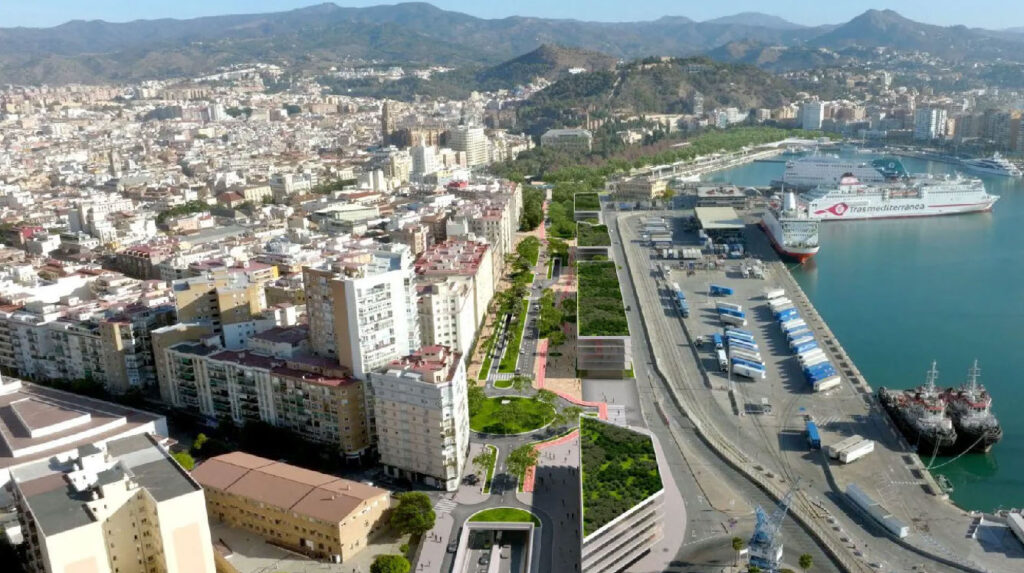
Infografía de la propuesta de ordenación del muelle 4 en el marco del Plan Litoral. (Ayuntamiento de Málaga, 2024).
Infographic of the proposed development of Pier 4 within the framework of the Coastal Plan. (Source: Malaga City Council, 2024).
El Plan Litoral: conexión verde y peatonal entre ciudad y puerto
The Litoral Plan: Green and Pedestrian Connection Between the City and Port
Una de las intervenciones más relevantes para el futuro del puerto de Málaga es el Plan Litoral, que tiene como objetivo principal la reordenación del tráfico en la Zona de Baja Emisiones, potenciando el transporte público con la construcción de dos nuevos intercambiadores y la recuperación de espacios públicos para el peatón en detrimento del vehículo privado mediante el soterramiento del eje viario formado por la Avenida Manuel Herrera Oria, el Paseo de los Curas y la Avenida Cánovas del Castillo (Ayuntamiento de Málaga, s.f.).
One of the most significant interventions for the future of Malaga’s port is the Litoral Plan, which has as its primary objective the reorganization of traffic in the Low Emission Zone. The plan aims to enhance public transport with the construction of two new interchanges and the recovery of public spaces for pedestrians at the expense of private vehicles, through the undergrounding of the road axis formed by Avenida Manuel Herrera Oria, Paseo de los Curas, and Avenida Cánovas del Castillo (Ayuntamiento de Malaga, n.d.).
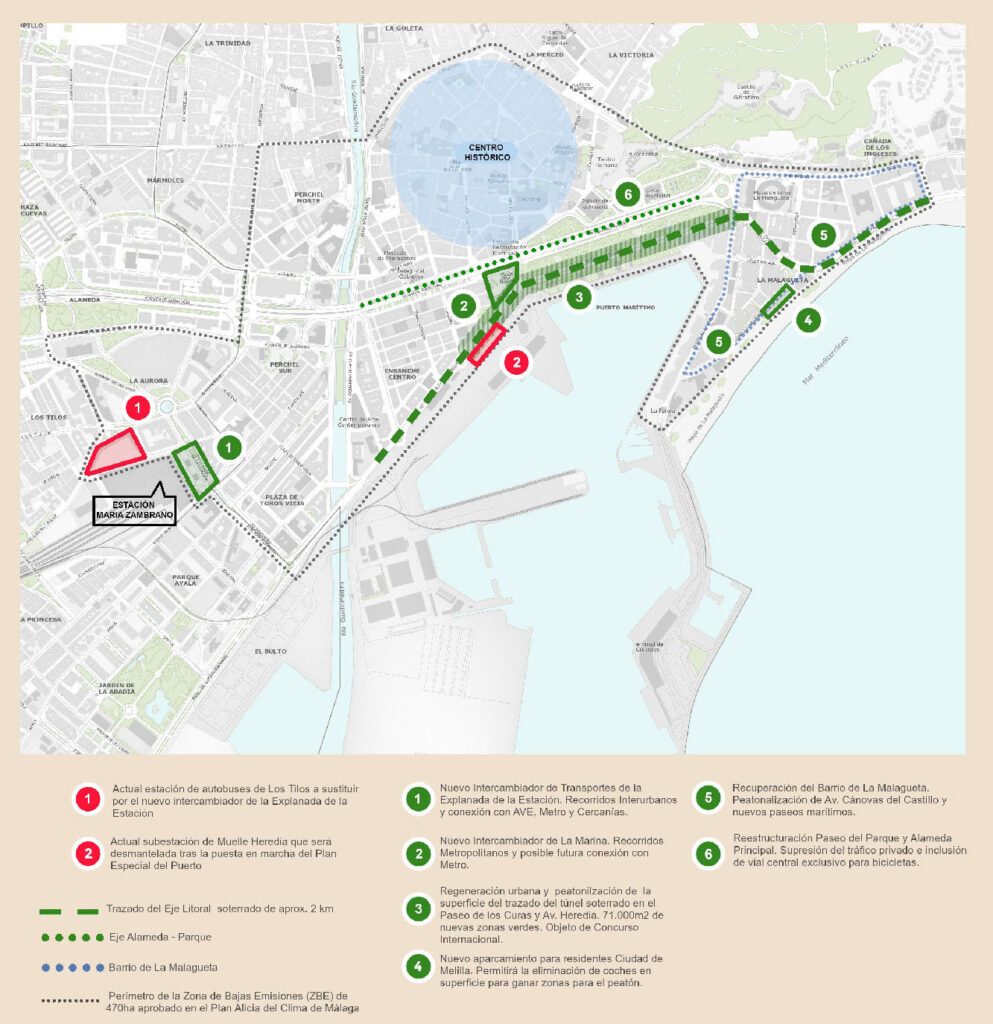
Esquema diagramático del Plan Málaga Litoral. (Autores: García Acón y Bañares Dorado, 2024).
Diagrammatic scheme of the Malaga Litoral Plan. (Authors: García Acón and Bañares Dorado, 2024).
El soterramiento facilitará integrar de manera armónica el puerto con la ciudad, eliminando las barreras físicas que aún separan al puerto del tejido urbano, conectando la Plaza de la Marina y el Parque de Málaga con las ya renovadas áreas portuarias. Por tanto, busca facilitar el acceso directo peatonal desde el centro histórico hasta la entrada histórica del Puerto de Málaga y el Palmeral de las Sorpresas. La operación permitirá además la creación de un corredor verde continuo que enlace el parque con el puerto, formando un espacio peatonal y verde en continuidad. La propuesta denominada Ecosistema Litoral ha sido redactada por el equipo formado por B720 Arquitectos, Luis Machuca y Asociados y DJ Arquitectura (2023).
La revitalización del entorno incluirá nuevas zonas de ocio y esparcimiento, así como espacios culturales y comerciales que complementarán las actividades ya existentes en el puerto. Este enfoque integral tiene como meta transformar el litoral en un punto de encuentro dinámico y multifuncional que refleje la identidad mediterránea de Málaga (Machuca Santa-Cruz & Olalla Mercadé, 2023).
Aunque la estrategia aspira a mejorar la movilidad urbana y reducir el impacto ambiental en el entorno del centro histórico, plantea dudas en cuanto a la reducción de los desplazamientos en vehículo privado de combustión y su contribución real a un modelo de ciudad a favor de la mitigación del cambio climático y una transición energética justa (Ruedas Redondas, 2023).
The undergrounding will help integrate the port with the city in a harmonious way, eliminating the physical barriers that still separate the port from the urban fabric, and connecting Plaza de la Marina and Malaga Park with the already renovated port areas. Therefore, the plan seeks to facilitate direct pedestrian access from the historic center to the historical entrance of the Port of Malaga and the Palmeral de las Sorpresas. The project will also allow the creation of a continuous green corridor linking the park with the port, forming a pedestrian and green space in continuity. The proposal called Ecosistema Litoral has been developed by the team consisting of B720 Arquitectos, Luis Machuca y Asociados, and DJ Arquitectura (2023).
The revitalization of the area will include new leisure and recreation zones, as well as cultural and commercial spaces that will complement the existing activities at the port. This integrated approach aims to transform the seafront into a dynamic and multifunctional meeting point that reflects Malaga’s Mediterranean identity (Machuca Santa-Cruz & Olalla Mercadé, 2023).
Although the strategy aims to improve urban mobility and reduce environmental impact around the historic center, there are concerns regarding the reduction of private combustion vehicle use and its real contribution to a city model that supports climate change mitigation and a fair energy transition (Ruedas Redondas, 2023).
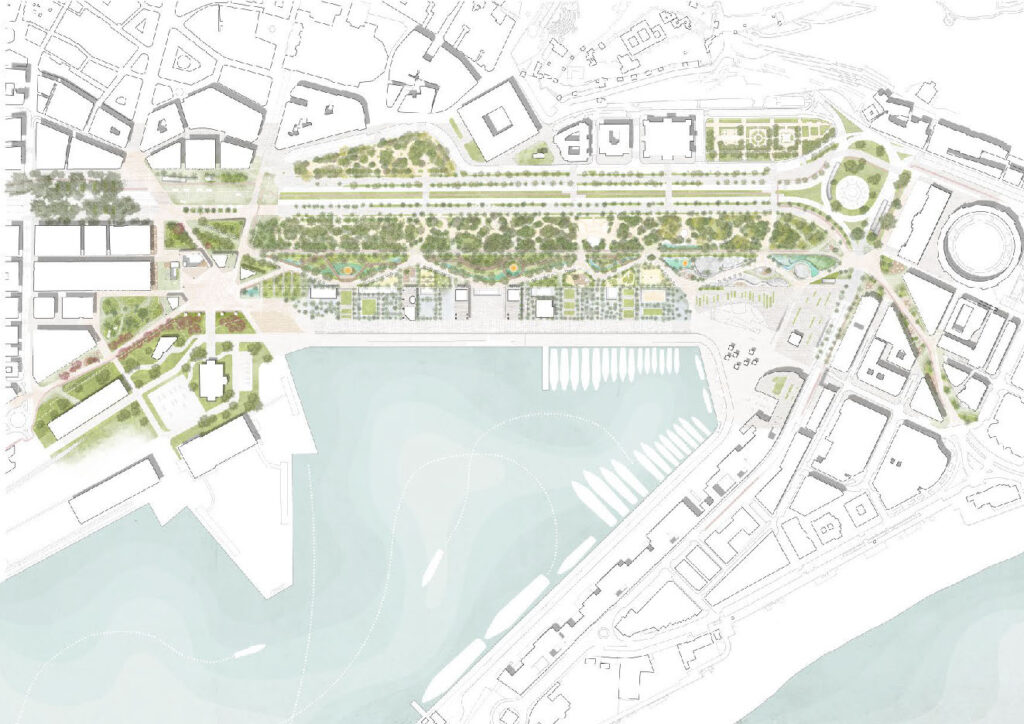
Propuesta Ecosistema Litoral de peatonalización y renaturalización de la superficie viaria soterrada. (Autores: B720 Arquitectos et al., 2023).
Coastal Ecosystem proposal for pedestrianisation and renaturalisation of the underground road surface. (Authors: B720 Arquitectos et al., 2023).
A modo de conclusión: retos y oportunidades para una regeneración sostenible
In Conclusion: Challenges and Opportunities for Sustainable Regeneration
La transformación del puerto de Málaga y la implementación de sus proyectos futuros presentan retos significativos. La conciliación de intereses entre el desarrollo económico, la sostenibilidad ambiental y las necesidades ciudadanas es una tarea compleja que requiere una planificación cuidadosa y la colaboración de todos los actores involucrados. Por otro lado, estas iniciativas también ofrecen oportunidades únicas para consolidar a Málaga como una ciudad portuaria moderna y sostenible. La integración del puerto con el tejido urbano, la creación de nuevos espacios públicos y la promoción de actividades culturales y recreativas son pasos cruciales reforzar el atractivo turístico de la ciudad, siempre y cuando supongan una mejora real y efectiva de la calidad de vida de los malagueños.
El puerto de Málaga está en una etapa de transformación dinámica que combina la recuperación de espacios históricos para uso ciudadano con la implementación de proyectos a medio-largo plazo. El hotel del dique de Levante, la ordenación del muelle Heredia, la transformación de la plataforma de San Andrés o el Plan Litoral deben ser ejemplos de regeneración sostenible de entornos portuarios obsoletos, que deben permitir a la ciudad adaptarse a las necesidades del siglo XXI sin perder su identidad histórica-patrimonial (Fernández Salinas & Silva Pérez, 2018). A medida que estos proyectos avancen, el puerto de Málaga tendrá la oportunidad de convertirse en una referencia internacional de integración urbana. Con una visión equilibrada que priorice tanto el desarrollo económico como el bienestar ciudadano, el puerto seguirá siendo un emblema de la historia y el futuro de Málaga.
The transformation of the Port of Malaga and the implementation of its future projects present significant challenges. Balancing the interests of economic development, environmental sustainability, and citizens’ needs is a complex task that requires careful planning and collaboration among all stakeholders involved. On the other hand, these initiatives also offer unique opportunities to consolidate Malaga as a modern and sustainable port city. The integration of the port with the urban fabric, the creation of new public spaces, and the promotion of cultural and recreational activities are crucial steps in strengthening the city’s tourist appeal, as long as they result in a real and effective improvement in the quality of life for the people of Malaga.
The Port of Malaga is undergoing a dynamic transformation that combines the recovery of historical spaces for public use with the implementation of medium- and long-term projects. The Levante Dock hotel, the development of Muelle Heredia, the transformation of the San Andrés platform, and the Litoral Plan should serve as examples of the sustainable regeneration of outdated port areas, enabling the city to adapt to the needs of the 21st century without losing its historical and heritage identity (Fernández Salinas & Silva Pérez, 2018). As these projects progress, the Port of Malaga will have the opportunity to become an international benchmark for urban integration. With a balanced vision that prioritizes both economic development and citizens’ well-being, the port will continue to be a symbol of Malaga’s history and future.
IMAGEN INICIAL | Vista aérea del puerto de Málaga. (Autoridad Portuaria de Málaga).
HEAD IMAGE | Aerial view of the port of Málaga. (Port Authority of Malaga).
╝
REFERENCIAS
REFERENCES
Andrade, M.J. & Peralta, A. (2015). “Proyectos Urbanos 1: La integración Puerto-Ciudad”. En: R. Báez Muñoz & P. Jiménez Melgar (Coord.) Agenda 21 Málaga 2015. Agenda urbana en la estrategia de sostenibilidad integrada 2020—2050 (pp. 167-172). Servicio de Proyectos Europeos. Observatorio de Medio Ambiente Urbano. Ayuntamiento de Málaga, Málaga.
Autoridad Portuaria de Málaga (2010). Plan Especial del Sistema General del Puerto de Málaga. Texto Refundido. Ayuntamiento de Málaga, Málaga.
Autoridad Portuaria de Málaga (2011). Modificación de paramentos y de la dotación mínima de aparcamientos en la Plataforma del Auditorio. Plan Especial del Sistema General del Puerto de Málaga, Málaga.
Autoridad Portuaria de Málaga (2023). Modificación puntual de elementos en la plataforma del morro e incremento del índice de edificabilidad máxima de la zona ciudadano-portuaria. Plan Especial del Sistema General del Puerto de Málaga. Ayuntamiento de Málaga, Málaga.
Autoridad Portuaria de Málaga (2024). Estudio de Detalle de ordenación de volúmenes de la Parcela K “Puerto Deportivo”. Plan Especial del Sistema General del Puerto de Málaga. Ayuntamiento de Málaga, Málaga.
Ayuntamiento de Málaga (s.f.). Plan Málaga Litoral, in https://planmalagalitoral.malaga.eu/.
Bernal Santa Olalla, B. (2018). Evaluación del impacto del hotel-rascacielos en el muelle de levante en el paisaje patrimonial de Málaga. Comité Nacional Español de Icomos, Madrid.
B720 | Fermín Vázquez Arquitectos, Luis Machuca Arquitectos & DJArquitectura (2023). Ecosistema Litoral. Anteproyecto Plan Málaga Litoral. Ayuntamiento de Málaga, Málaga.
Benedicto Calahorra, A. (2017). Sobre el Auditorio de Málaga. Fundación CIEDES, Málaga.
Costa, A., de la Torre, C. & Peralta, A. (2005). “El Plan Especial del Puerto de Málaga. Breve Historia de un Largo Proceso”, in Interreg III B. Cooperación de metrópolis mediterráneas. Proyecto piloto integración de puerto y ciudad. Ayuntamiento de Málaga, Málaga.
Fernández Salinas, V. & Silva Pérez, R. (2017). “Reinvención patrimonial y revitalización urbanística: a propósito del modelo malagueño”, in Ciudad y Territorio Estudios Territoriales, vol. 4, no. 191, pp. 63-79.
Fernández Salinas, V. & Silva Pérez, R. (2018). “Aportación al debate: sobre los valores patrimoniales de los espacios portuarios: aplicación al puerto de Málaga”, in F. Cebrián Abellán (Coord.) Ciudades medias y áreas metropolitanas: de la dispersión a la regeneración, pp. 583-602. Ediciones de la Universidad de Castilla-La-Mancha, Ciudad Real.
García Acón, C. y Bañares Dorado, M. (2023). Anteproyecto del eje litoral soterrado en la ciudad de Málaga. Documento de Síntesis. Ayuntamiento de Málaga.
Gerencia Municipal de Urbanismo de Málaga (2024). Proyecto de renaturalización urbana en el sector Huelin-Ayala. Ayuntamiento de Málaga.
López-Bravo, C. & Navas-Carrillo, D. (2019). “Patrimonio y cultura: recursos para el desarrollo urbano. Málaga como laboratorio”, in Revista PH, Boletín del Instituto Andaluz de Patrimonio Histórico, no. 97, pp. 155-157.
Machuca Santa-Cruz, L. (1997). Málaga, Ciudad Abierta. Origen, cambio y permanencia de una estructura urbana. Colegio Oficial de Arquitectos de Málaga, Málaga.
Machuca Santa-Cruz, L. & Olalla Mercadé, L. (2023). “Ecosistema litoral”, in Boletín de la Academia Malagueña de Ciencias, no. 25, pp. 93-104.
Márquez-Ballesteros, M.J., García-Moreno, A.E. & Pérez-Chachoui, J.M. (2024). “Cuarenta años a la espera de un bosque. Cronología social para la defensa del espacio verde urbano en Málaga”, in M.J, Márquez-Ballesteros, K. España, C. Rosa-Jiménez (Coord.). Mediterranean Landscape in Transition. Nuevos enfoques para hacer frente a los nuevos retos sociales y medioambientales, pp. 309-328. Tirant Humanidades, Madrid.
Reinoso Bellido, R. (2005). Topografías del paraíso. La construcción de la ciudad de Málaga entre 1897 y 1959. Colegio Oficial de Arquitectos de Málaga; Colegio Oficial de Aparejadores y Arquitectos Técnicos de Málaga, Málaga.
Ruedas Redondas (2023). ¿Por qué no apoyamos el Plan Litoral de Málaga?, in https://www.ruedasredondas.org/.